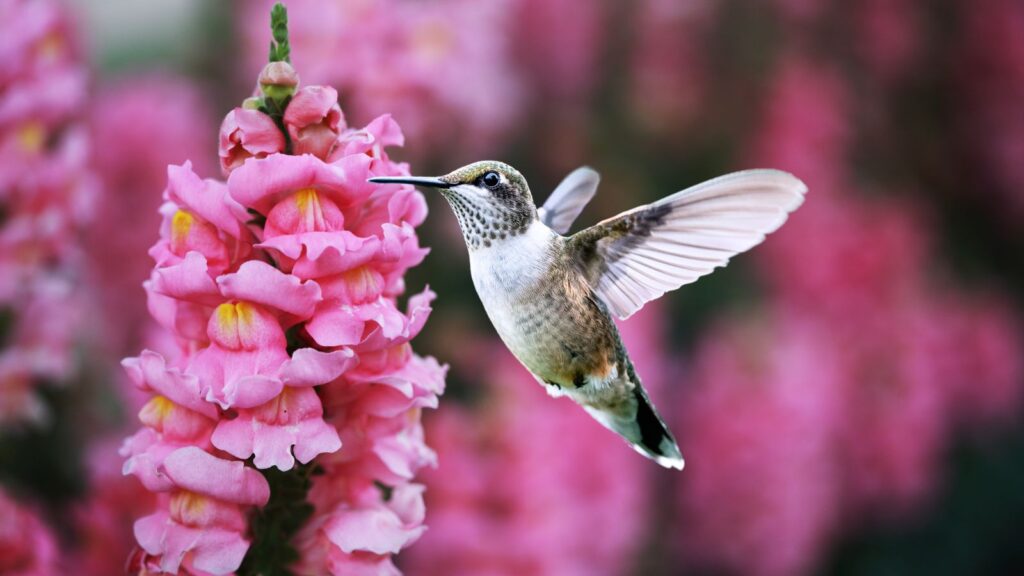Snapdragon plants feature bright, beautiful flowers that make them a favorite of backyard gardeners and hummingbirds alike.
Popular snapdragons belong to a group of species in the Antirrhinum genus native to Europe. They’re called snapdragons (or sometimes dragon flowers) for their resemblance to dragons if you snap off a flower head and squeeze at the base of it, giving the appearance of a dragon’s mouth opening and closing.
Take a look:
There are native hummingbirds in parts of western North America, but the most popular plants in the group come from European origins.
Why Do Hummingbirds Like Snapdragons?
Snapdragons’ nectar-filled flowers have vibrant, bright colors that range from hummingbird favorites like red, yellow, and orange to classic pinks, whites, and purples.
Some snapdragon species can grow up to four feet tall with dozens of deep flowers that can provide ample food for numerous hummingbirds and other pollinators like bees.
Do Snapdragons Attract Other Wildlife?
Speaking of bees and other wildlife, pollinators like butterflies and bees will readily visit snapdragon flowers, which are a great source of sweet nectar, but a couple of often unwanted garden guests might not be so enthusiastic.
While many people love all kinds of wildlife like deer and rabbits, they don’t always love seeing them in their gardens, where they can be quite destructive. Snapdragons may have sweet-smelling flowers, but they have a bitter taste that is not preferred by mammals, which have thousands of taste buds.
How animals perceive taste is an interesting topic. We don’t know exactly how many animals react to bitter, sweet, or spicy foods, but mammals like humans have about 10,000 taste buds, according to the University of Wisconsin-Madison Professor Anna Pidgeon. Chickens, on the other hand, have just 24 taste buds and pigeons have 37.
Most Common Snapdragons and the Snapdragons of Western North America
Two of the most frequently grown snapdragons, the garden snapdragon, and the common snapdragon, are not native to the United States. The common snapdragon (Antirrhinum majus) is native to the Mediterranean but has become a popular garden plant across the world.
It’s OK to plant these non-native species in your garden, and the hummingbirds will like them just the same, but you can do a lot of good for your backyard ecosystem by planting native species.
Native species support dramatically more species of caterpillars and insects than non-native species, providing the foundation for a strong backyard ecosystem. This means that birdwatchers with native backyard plants are likely to support more birds than non-native plants.
There are native snapdragon species in some parts of western North America, mostly California.
The Plantaginaceaefamily consists of native snapdragons. Some rearranging of plant classifications means that New World snapdragons in the Sairocarpus genus, for example, are no longer included in the common snapdragon’s genus, Antirrhinum, where they formerly belonged.
While their ranges are quite restricted, here are some native North American snapdragon species:
Sierra Snapdragon (Sairocarpus multiflorus): endemic to California, including mountain ranges such as the Sierra Nevadas
Wiry snapdragon (Sairocarpus vexillocalyculatus): native to California and Oregon, also known as the sailflower snapdragon or Brewer’s snapdragon
Tall snapdragon (Sairocarpus virga): native to the North Coast Ranges of California
But as mentioned earlier, don’t shy away from planting snapdragons in your garden beds, even common snapdragon or garden snapdragon. They’re non-invasive and they’re not going to spread across the area and displace native species, meaning the common snapdragon is still a good choice for gardens.
How To Grow Snapdragon Plants

Here are the recommendations for growing common snapdragon, according to the experts over at Colorado State University Extension:
Snapdragons require well-drained soil high in organic matter and regular watering of about an inch per week. CSU reports that common snapdragons can be overwintered with protection in Zones 5, 6, and 7, and can handle frost and cold temperatures.
As annual plants, snapdragon plants can grow just about anywhere, and they often thrive in cooler months, including in the fall.
With little work, you can enjoy the snapdragon’s bright flowers in your garden for many months each year.
In Conclusion
Snapdragons are ideal plants for a variety of pollinators across the world, including hummingbirds in the Americas, where they have been introduced.
While you may want to consider a garden of primarily native plants that create a lively ecosystem, a snapdragon is a great plant for hummingbirds that is non-invasive and can be grown just about anywhere.
Frequently Asked Questions
What Are Other Names for Snapdragons?
Snapdragons are known by multiple names, including toadflax and dog flower. Some individual species of snapdragon may also have many names, such as the wiry snapdragon, also known as the sail flower snapdragon or Brewer’s snapdragon.
Where Do Snapdragons Grow Best?
Gardeners can plant snapdragons as annual plants just about anywhere. As perennial plants, they can be overwintered in zones, 5, 6, and 7, according to Colorado State University Extension.
This includes a good portion of the United States. Click here for a hardiness zone map.


